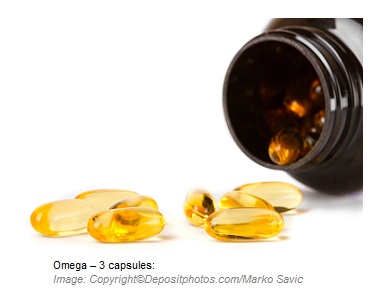 their structures. They are essential fatty acids, which means the body cannot make them.
their structures. They are essential fatty acids, which means the body cannot make them.There are over 10 types of Omega – 3 fatty acids in the nature, and the most common types are: EPA (eicosapentaenoic acid), DHA (docosahexaenoic acid), and ALA (alpha- linolenic acid). EPA and DHA are animal – based Omega -3 fatty acids, while ALA is a plant – based Omega – 3 fatty acid.
Food Sources:
Omega- 3 fatty acids are found in animal and plant sources. Animal sources are fish and krill, and common plant sources include perilla, flaxseeds, chia seeds, hemp seeds, walnuts, butternuts, canola, soybeans, sea buckthorn, and pumpkin seeds. For more information about amounts of Omega-3 fatty acids in different foods, see “Omega – 3 Fatty Acids” under the section of “GH Enhancers”.
Omega – 3 fatty acids are found almost in all fruits and vegetables. For the contents of Omega – 3 and Omega – 6 fatty acids in fruits and vegetables, click on the links below:
Omega-3 and Omega-6 Fatty Acids in Fruits
Omega-3 and Omega-6 Fatty Acids in Vegetables
Athletic Benefits of Omega – 3 Fatty Acids:
Omega – 3 fatty acids may benefit athletes in many ways: 
- They stimulate the release of growth hormone, which increases lean muscle mass and decreases body fat.
- They help athletes recuperate quickly from intense training sessions or competitions.
- They may enhance oxygenation to the working muscles.
- They may improve athletic endurance.
- They help athletes recover faster from sports injuries, such as bursitis, tendinitis, strains and sprains.
- They may reduce blood levels of catabolic hormone.
- They have a protective effect against overtraining syndrome.
For more information regarding athletic benefits of Omega-3 fatty acids, see “Omega – 3 Fatty Acids” under the section of “GH Enhancers”.
Non – Athletic Benefits of Omega – 3 Fatty Acids:
The following conditions may benefit from Omega – 3 fatty acids:
- High levels of LDL cholesterol and triglyceride.
- Heart diseases.
- Depression.
- High blood pressure.
- Asthma.
- Atherosclerosis.
- Osteoarthritis (OA).
- Rheumatoid arthritis (RA).
- Multiple sclerosis (MS).
- ADHD (attention – deficit hyperactivity disorder).

- Crohn`s disease.
- Diabetes.
- Ulcerative colitis.
- Bipolar disorder.
- Anxiety.
- Schizophrenia.
- Alzheimer’s disease.
- Skin disorders: psoriasis, dermatitis, burns, and dry skin.
- Eye problems: glaucoma, cataracts, age- related macular degeneration, and dry eyes.
- Cystic fibrosis.
- Systemic lupus erythematosus (SLE).
- Cancer prevention: breast, prostate, and colon.
- Dysmenorrhea (painful menstruation).
- COPD (chronic obstructive pulmonary disease).
- Sickle cell anemia.
- Compromised immune system: AIDS, post – surgery, and irradiation therapy.
Dosage and Side Effects:
The recommended daily doses of Omega – 3 fatty acids for men and women are 1.6 grams and 1.1 grams, respectively. According to the FDA, adults could consume safely up to 3 grams a day, with maximum 2 grams a day from dietary supplements.
Also the American Heart Association has suggested the following guidelines:
After heart attack: 1gram a day of EPA and DHA.
To lower triglyceride level:2 – 4 grams a day of EPA and DHA.
Larger doses of Omega – 3 fatty acids may be required in the following conditions:
- Multiple sclerosis.
- ADHD.
- Endurance athletes.
The usual doses of Omega -3 fatty acids have usually no side effects, but higher doses (more than 3 grams a day) might lead to:
1) Belching.
2) Stomach upset.
3) Nausea.
4) Diarrhea.
5) Soft stool.
6) Fish breath or fishy aftertaste.
7) Heavy metals (mercury, arsenic, cadmium, and lead) accumulation in the body in higher doses in the long term. In reality, this is highly unlikely, as heavy metals bind with protein in the fish flesh rather than accumulating in the oil.
8) Elevated blood sugar level (adding vitamin E may prevent this).
9) Increased bad cholesterol level (garlic supplement may prevent this).
10) Increased risk of bleeding.
Contraindications and Interactions of Omega – 3 Fatty Acids:
Omega -3 fatty acids are contraindicated in the following conditions: 
- People who take medications to prevent from blood clotting (blood thinners, e.g. Warfarin).
- Along with anti – platelet medications, such as clopidogrel, prasugrel, ticlopidine, abciximab, eptifibatide, and dipyridamole.
- During pregnancy.
- During breastfeeding.
- Allergy to ingredients.
- Liver problems (with elevated liver enzymes)
Omega – 3 fatty acids should be used with caution in the following conditions. In other words, the following conditions require lower doses of Omega – 3 fatty acids (maximum 1 gram a day):
- Along with Advil, Aspirin, and Ginkgo Biloba.
- Bipolar disorder.
- Diabetes type II.
- AIDS and advanced cancers (avoid higher doses).
- Implanted cardiac defibrillator.
- People with cardiac pacemaker.
Ratio of Omega – 6 to Omega – 3 Fatty Acids:
The ratio of Omega−6 to Omega−3 is very important in maintaining cardiovascular health.
Healthy ratios of Omeg−6 to Omega −3 range from 1:1 to 1:4, which means that an individual needs more Omega−3 than Omega−6. Typical Western diets provide ratios of between 10:1 and 30:1 (average 15:1).

